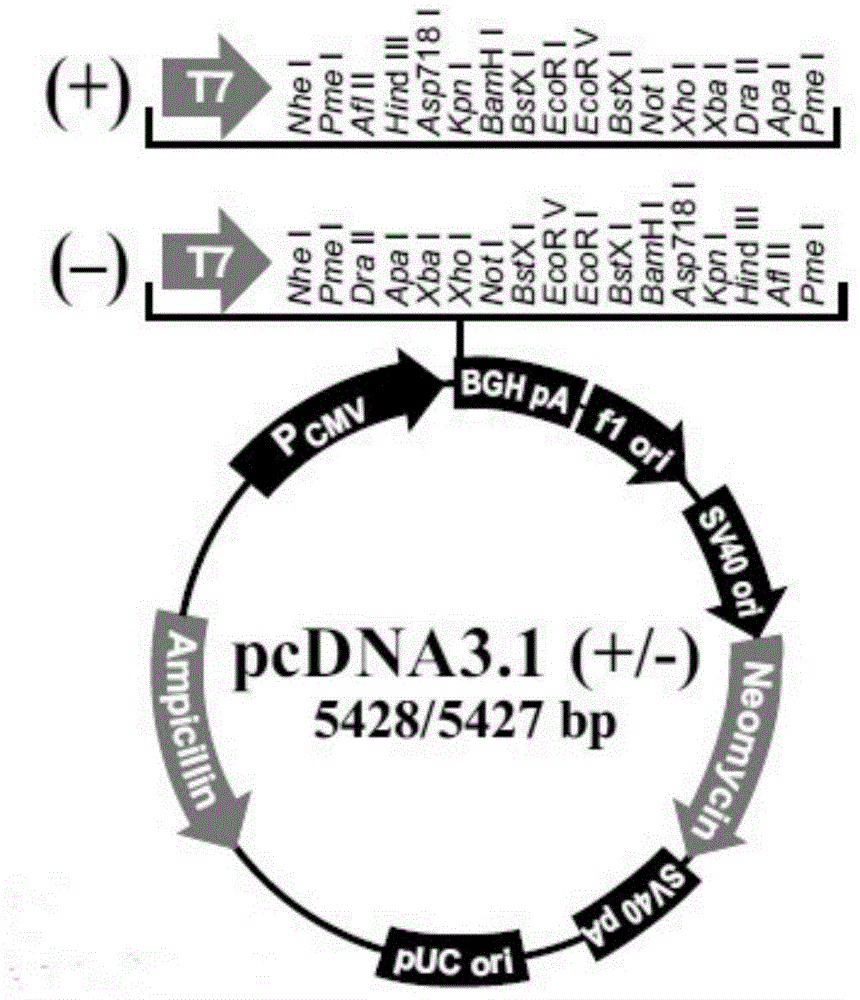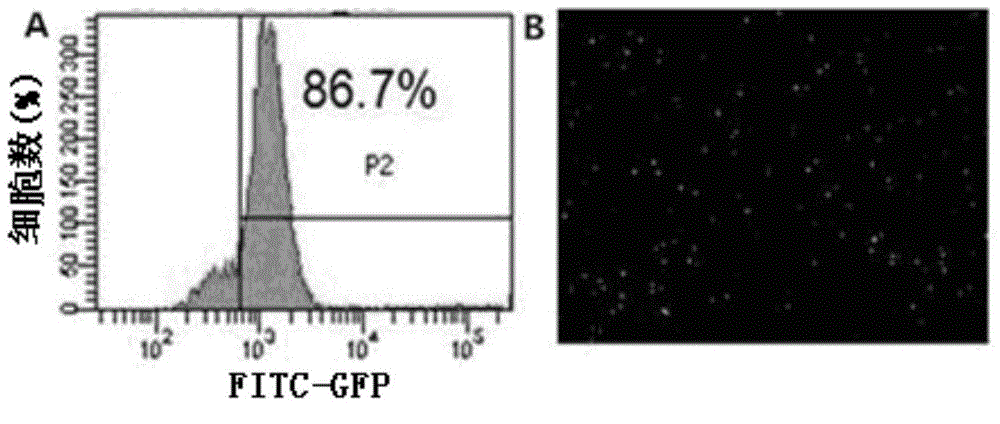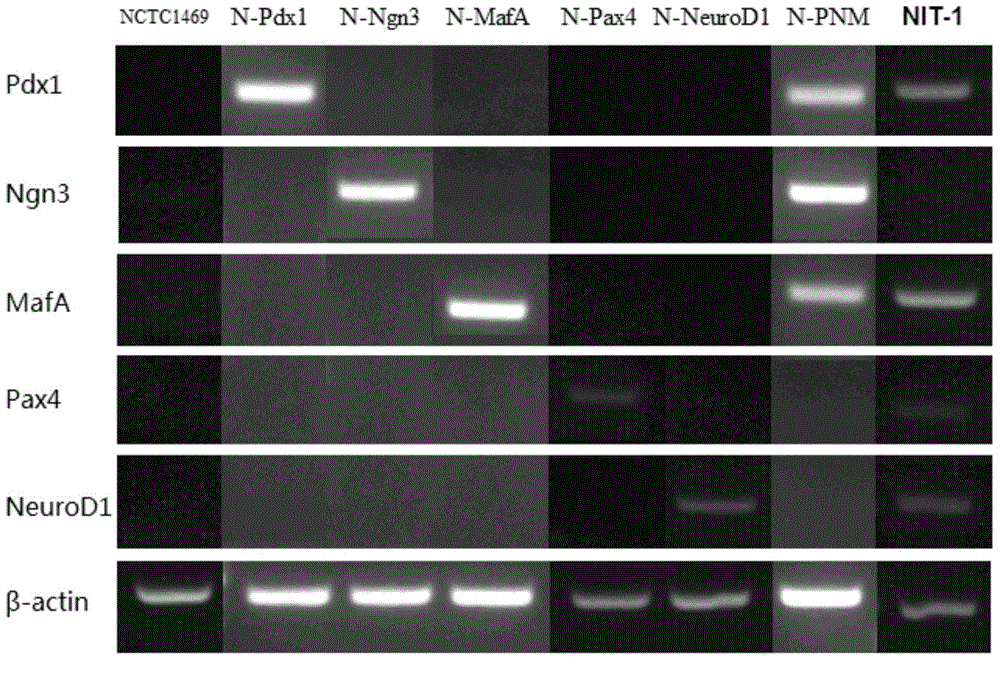Method for directly reprogramming mouse hepatocyte into islet beta cell, and application thereof
A β-cell and reprogramming technology, which is applied in the direction of insulin, animal cells, vertebrate cells, etc., can solve the problems of safety, low reprogramming efficiency, and poor maturity, and achieve improved safety, high transfection efficiency, and improved effect of maturity
- Summary
- Abstract
- Description
- Claims
- Application Information
AI Technical Summary
Problems solved by technology
Method used
Image
Examples
Embodiment 1
[0078] Example 1, Construction, Identification and Efficiency Evaluation of Transcription Factor Plasmid Expression Vector
[0079] 1. Construction of transcription factor plasmid expression vector
[0080] The following genes Pdx1 (SEQ ID NO: 2), Ngn3 (SEQ ID NO: 1), Mafa (SEQ ID NO: 3), Neurod1 (SEQ ID NO: 4) and Pax4 (SEQ ID NO: 5) were artificially synthesized.
[0081] The amino acid sequence of protein Pdx1 encoded by gene Pdx1 is sequence 6;
[0082] The amino acid sequence of protein Pdx4 encoded by gene Pdx4 is sequence 7;
[0083] The amino acid sequence of the protein Neurod1 encoded by the gene Neurod1 is SEQ ID NO:8.
[0084] 1. Construction of tandem vectors pcDNA3.1(+)-Pdx1+Ngn3+Mafa—GFP and pcDNA3.1(+)-Pdx1, Ngn3, Mafa, Neurod1, Pax4
[0085] 1) Construction of tandem vector pcDNA3.1-Pdx1-2A-Ngn3-2A-Mafa-EGFP
[0086] The pcDNA3.1-Pdx1-2A-Ngn3-2A-Mafa-EGFP vector is a DNA fragment between the BamHI and HindIII restriction sites of the pCDNA3.1-EGFP vector r...
Embodiment 2
[0130] Example 2. Screening and identification of optimal transcription factor combinations and transfection time for direct cell reprogramming
[0131]In this experiment, by studying the order in which different transcription factors play a role and screening the best combination and time of reprogramming efficiency and maturity at different transfection periods, the reprogrammed β cells are identified from the aspects of genes and proteins, which will provide future reference. The clinical application lays the foundation, as follows:
[0132] The five recombinant vectors prepared in Example 1 were transfected into the NCTC-1469 mouse liver cell line according to the following grouping:
[0133] (1) Combination 1Pdx1+Ngn3+Mafa: the recombinant vector pcDNA3.1(+)-Ngn3(N-Ngn3), pcDNA3.1(+)-Mafa(N-Mafa), pcDNA3.1(+)-Pdx1( N-Pdx1) was mixed and co-transfected into the NCTC-1469 mouse liver cell line according to the mass ratio of 1:1:1;
[0134] (2) Combination of 2Pdx1+Ngn3+Ne...
Embodiment 3
[0237] Example 3. Research on the treatment of diabetes by directly reprogramming mouse liver cells into β cells
[0238] In this study, by constructing a mouse model of diabetes, the optimal combination and reprogrammed pancreatic islet β cells screened in the previous stage were transplanted under the left renal capsule of diabetic mice, and the blood glucose changes of the mice were monitored. Monitor the release of insulin and C-peptide, evaluate the hypoglycemic effect on diabetic model mice, and provide a certain basis for clinical treatment of diabetes.
[0239] 1. Construction of diabetes model
[0240] (1) After feeding SCID-Beige mice for 1 week, the body weight is about 20-25g.
[0241] (2) The mice were fasted for 14 hours without water, and the concentration of the prepared STZ solution was 20mg / ml; that is, 5-6ul / g mouse body weight.
[0242] (3) After the mice were injected with STZ, they were fed normally, blood was collected through the tail vein every morni...
PUM
 Login to View More
Login to View More Abstract
Description
Claims
Application Information
 Login to View More
Login to View More - R&D
- Intellectual Property
- Life Sciences
- Materials
- Tech Scout
- Unparalleled Data Quality
- Higher Quality Content
- 60% Fewer Hallucinations
Browse by: Latest US Patents, China's latest patents, Technical Efficacy Thesaurus, Application Domain, Technology Topic, Popular Technical Reports.
© 2025 PatSnap. All rights reserved.Legal|Privacy policy|Modern Slavery Act Transparency Statement|Sitemap|About US| Contact US: help@patsnap.com



